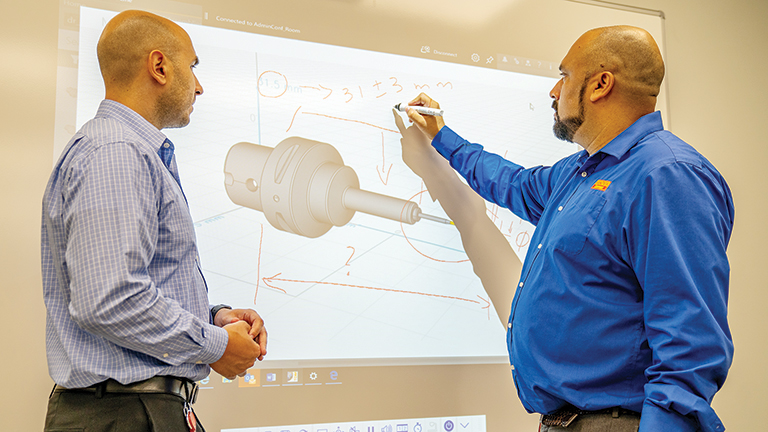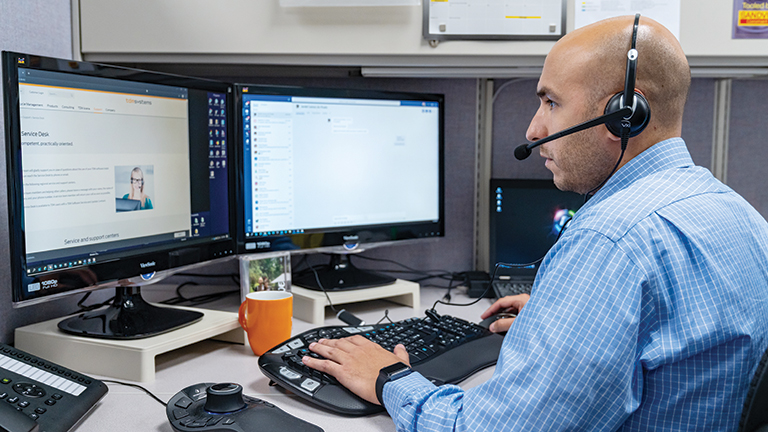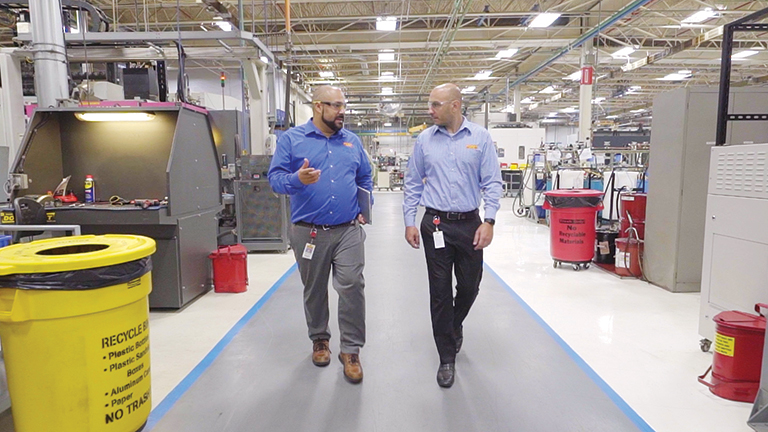Part 3: Getting Started on Going Digital

In this final installment of the Connected Machine Shop series, we’ll tackle the more technical and implementation-oriented aspects of an Industry 4.0 transformation. Where Part 1 described the vision behind digital machining and Part 2 built the business case, in Part 3 we strip the wires, configure the ports, and plug in the network adapters. When done, your shop will have unprecedented visibility into what makes your machining processes tick, and why they sometimes don’t. It’s time to get digital.
Perhaps the first thing to know is that a digital machining strategy doesn’t depend on the latest, greatest machine tools. Sure, it would be nice to have a factory floor chock full of shiny new CNC lathes and machining centers, but that’s not reality. Most shops have a blend of equipment vintages, with a few recent purchases, some in their early teens, and one or two ready for Social Security.
As mentioned in Part 2 of this series, machines purchased within the last decade or so are excellent candidates for remote monitoring and the collection of process data. Once connected to the network, these machine tools are willing partners in the digital machining dance, able to share information with Sandvik Coromant’s MachiningInsights or a comparable analytics software platform.
Older machines might require more effort to make them talkative, although the technology exists to make most any equipment Industrial Internet of Things (IIoT) capable. Try an Internet search for “retrofitting legacy machine tools” or a similar phrase and you’ll find there are plenty of hardware options, many of them surprisingly affordable. Otherwise, talk to your machine tool distributor, or find a company that specializes in remote machine tool monitoring.

The Merit of Baby Steps
Of course, it’s best to avoid getting bogged down in minutiae like this when launching a digital machining initiative. Assuming you have at least one or two IIoT-ready machines, start there. Pick the low-hanging fruit, build on your successes, and worry about the old-timers later, after everyone has become convinced of the project’s merits. Jeff Rizzie, Sandvik Coromant’s director of digital machining, calls this the “think big, start small, and move quickly” approach to an Industry 4.0 implementation.
Julio Vasconcelos, engineering manager for Sandvik Coromant’s production facility in Mebane, N.C., agrees. “We entered into this in late 2018 not knowing where to start or what to expect,” he said. “We decided to grab the easy stuff first, hoping to realize some immediate benefits, and then expand from there. Today, we have a couple dozen machines running MachiningInsights, and we’ve reduced downtime by more than 25 percent.”
One unavoidable first step is getting your machine tools on the network. If you’re still sending programs to the shop floor via RS-232, or worse, using sneakernet and USB sticks, it’s time to establish Ethernet connectivity. There’s no reason to get into the weeds of TCP/IP and network protocols and all that technical mumbo-jumbo—assuming the front office has computers and Internet access, it’s a simple enough matter to extend that infrastructure throughout the rest of the facility. No big deal.
There is one network protocol you will need to familiarize yourself with, though: MTConnect. Since its introduction in 2008, it has become the de facto standard for read-only communications between machine tools and external software systems. Most machine tool manufacturers today include MTConnect as standard or offer it as an option.
Other protocols exist, including the OPC UA (Open Platform Communications United Architecture) standard, which supports read-write communications. Now’s the time to start doing your homework on each.
There’s more techno-speak to come, but it’s important to recognize that none of this is as complicated as it might sound. Bijal Patel, a senior digital machining specialist at Sandvik Coromant, suggested that getting started with Industry 4.0 is no more difficult than connecting a machine tool to the cloud (a term we’ll come back to) and analyzing what emerges. “A typical CNC is streaming dozens of data points every few seconds, and it doesn’t take long to realize you can do some really cool things with that information, stuff that was never before possible,” he said.
Compare this to the typical Lean and Kaizen event, where the data needed to drive continuous improvement activities is collected in a manner that is decidedly un-Lean: manually, by writing it down or typing it into a spreadsheet. According to Patel, manufacturing analytics platforms like MachiningInsights not only eliminate this tedium, but make data more accurate, comprehensive, and readily available.
“If you truly want to pursue a next-generation machining strategy, you need to implement a monitoring solution that lets you easily see what your machines are doing,” he said. “MachiningInsights lets you connect to practically any machine tool with minimal hassle. It’s subscription-based, so there’s no massive software investment, and it resides in the cloud, so it’s both scalable and easier to deploy. But the real power comes from its machine learning and analytical capabilities, as these are what help shops become more efficient and their processes more predictable.”

Gazing Skyward
You’ll be hearing it a lot more about the cloud as people recognize its merits. Cloud computing is no different than regular computing, except that the servers are offsite, housed in secure data centers across town or across the country. These facilities are often hosted by giants such as Amazon and Microsoft, as well as other less well-known names, and tended by teams of trained IT people.
The advantages of cloud-based computing are manifold. Because there are multiple servers in a data center, computing tasks can be shared, leading to better use of resources. The cloud is also scalable. This means you can sign up for as much disk space and CPU power as you require today, and then extend your piece of the “farm” as your needs and business grows. There’s no more need for software patching and security updates (this is the data center’s job), nor worries over how much or how little on-site server power to invest in (you can always make adjustments later). The result is better performance, lower costs, and increased flexibility.
But what about security, you ask? “I don’t want my company’s data sitting hundreds of miles away, protected by people I don’t know,” you might say. It’s a fair point, but remember this: because the cloud is monitored by tech-savvy humans using advanced software systems, it is far less hackable than the servers found in many manufacturing companies, some of which are managed by the shop’s programming team or someone less capable.
That’s not to say you won’t need IT people. Quite the contrary. A digital machining strategy means technically-capable team members are more necessary than ever before. “Get them involved,” said Patel. “You’re about to implement a monitored solution that will impact every part of the company. It needs a stable, secure network and computer infrastructure to operate, so step one is to engage with the IT team.”

The concept of machine operators and manufacturing engineers working closely with the people they would typically turn to for password and email problems represents a fundamental change for many, but is just one more aspect of Industry 4.0. Further, the IT group’s project involvement must be active. As keepers of the company’s data security and performance keys, they ultimately need to bless any activity that touches their piece of the corporate landscape.
They will also be needed farther down the road. If you follow Rizzie’s recommendations, you’re going to start small and begin picking the low-hanging fruit. But what comes after? Perhaps you’ll want to import your newfound data into the shop’s ERP system or send tool length information from the offline tool presetter to the programming software. You will need people familiar with APIs (application programming interfaces) and similarly geeky terms. As Patel noted, “We see the greatest success comes when folks involve the IT department even before they ask management for funding.”
There’s more to a well-oiled project team than this, however. Although the implementation of MachiningInsights or a comparable system is a solid first step down the Industry 4.0 road, it’s still just that: a first step, and hopefully the first of many. With this in mind, representatives are needed from each of the departments that will be affected by the results:
- The shop’s programmers, setup people, engineers, and machine operators are obvious—they will be using the software, entering job information and reason codes, and sending alerts if something goes awry.
- Quality control should at least be made aware of the project, as what better way to affect part accuracy and consistency—for better or worse—than to embark on a shop floor continuous improvement initiative.
- The finance people need to be involved, since they must not only figure out how to pay for the investment but will be responsible for the profit (or loss).
- Participation from upper management is a must, but should be kept to a dull roar—no micro-management needed here, only support and encouragement.
- Someone must be charged with ongoing data analysis, and, more importantly, figuring out what to do with the conclusions. The machining and engineering folks will likely be at the top of this list, and they should be afforded the time needed to perform this task. The good news is it will get easier as the system gets smarter and the shop grows more comfortable with it.
- Finally, there should be a project champion. Ironically, this might well be one of the IT people mentioned earlier, although they could come from engineering or the shop floor. Whoever it is, they should have the authority to recommend additional investments and make process changes (within reason).
The moral to this story is clear: there’s going to be a lot of change. And, as stated in the first sentence of Part 1 of this series, “Change is hard.” Who’s going to manage all that change? As with an ERP implementation or the firing up of a shop’s first multitasking machine, there will be questions raised and second-guesses proffered. Are you ready for it?
Happy (and Profitable) Endings
Julio Vasconcelos had a few of these questions when he helped with the machine monitoring and analytics rollout at Mebane. And while he still has occasional questions, finding the answers has become easier. “We now have the data, and are able to make more educated decisions. If machine utilization is down or a job is running late, we know it immediately—not the next day or week, after it’s too late. We can take the appropriate actions based on actual information, not tribal knowledge or assumptions or hearsay.”
More importantly, the system has generated a company-wide culture change. Everyone wants to do the best job they possibly can, he pointed out—machinists and managers alike. Because a digital machining strategy makes the shop more efficient, with fewer surprises and a greater amount of tangible success, working there makes one feel like a member of the pit crew on a winning race team. “People are happier when they’re producing something and everything is moving in the right direction,” Vasconcelos said. “That’s what MachiningInsights has done for us.”
Rizzie offers a somewhat surprising final take on Industry 4.0. “I think it gets in the way. It’s confusing, because there’s so much there to think about. When you get right down to it, Industry 4.0 is just as applicable to someone making Coca-Cola as it is to someone machining components for aircraft engines, but it means completely different things to each of them. Both are manufacturing processes, both are complicated, and both require different solutions to their everyday problems. For me, the Connected Machine Shop concept cuts through all the clutter of Industry 4.0 to answer one specific question: how do we solve problems in the machine shop? How do we address this particular vertical and use digital technology to increase productivity? That’s what’s most important to me.”
"machine" - Google News
October 30, 2020 at 07:04PM
https://ift.tt/31WFK9v
The Connected Machine Shop - Advanced Manufacturing
"machine" - Google News
https://ift.tt/2VUJ7uS
https://ift.tt/2SvsFPt
Bagikan Berita Ini















0 Response to "The Connected Machine Shop - Advanced Manufacturing"
Post a Comment